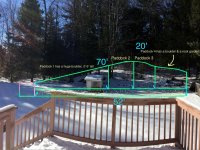Hemlock
Chillin' with the herd
- Joined
- Jan 20, 2016
- Messages
- 16
- Reaction score
- 7
- Points
- 26
Background: I'm on 1.6 small acres. I've been wanting to move to a property with more acreage, but bc we bought when we did, we're upside down on our mortgage. We need to stay put for a long time. We love our house and our property (other than size), just not the lots of driving we have to do. So our plan is to put in a garage/barn (that'll be another post) and put in fencing so we can get 2 Nigerian Dwarf goat kids and their future offspring. I can't see us ever having more than 10 goats before the kids are weaned and sold or whatever. Our property has a hill out back that I'd like to place their paddocks on. It's brush/immature forest that was cleared by the builder or previous homeowners. It's mostly young beech trees with some young hemlock trees (not poisonous hemlock plants) and young pines. There's moss then grass in front of this area. The rock wall was made by us last year and easily moved.
I know we're talking a small area here, but if it's not too cramped, I'd like 4 separate areas so I can rotate them and possibly an aisle to direct them from their daytime shelter (4'x5.5' w/ a 2' covered porch). As this will be just 1 of my start up costs, I'll likely have to do 1 or 2 areas and add on over time.
Hopefully I properly attached a diagram. The pink square is where I'd like to move the daytime shelter to. The blue lines are gates.
I'm thinking 5' 2x4 no climb horse fence with 8' wooden posts and a hot wire near the bottom and another above the top. The hill has 2 boulders that I think the goats would enjoy playing on, but the biggest issue is that the large one is tall (hence the 5' fence), and I'm worried the goats or the neighbors dogs could easily go over the top. I guess I could move the fence further from the boulder, but the hill is steep behind it and there's a drop off a few feet to the left of it. Does anyone have any ideas on whether this will work or not? Any tips or changes you can suggest? Thank you for your help.
I know we're talking a small area here, but if it's not too cramped, I'd like 4 separate areas so I can rotate them and possibly an aisle to direct them from their daytime shelter (4'x5.5' w/ a 2' covered porch). As this will be just 1 of my start up costs, I'll likely have to do 1 or 2 areas and add on over time.
Hopefully I properly attached a diagram. The pink square is where I'd like to move the daytime shelter to. The blue lines are gates.
I'm thinking 5' 2x4 no climb horse fence with 8' wooden posts and a hot wire near the bottom and another above the top. The hill has 2 boulders that I think the goats would enjoy playing on, but the biggest issue is that the large one is tall (hence the 5' fence), and I'm worried the goats or the neighbors dogs could easily go over the top. I guess I could move the fence further from the boulder, but the hill is steep behind it and there's a drop off a few feet to the left of it. Does anyone have any ideas on whether this will work or not? Any tips or changes you can suggest? Thank you for your help.


 pleasure!
pleasure!